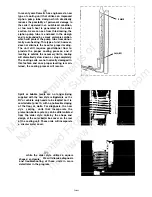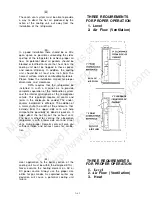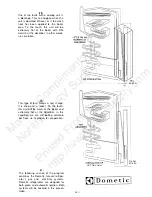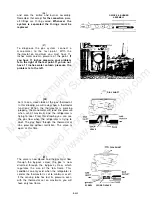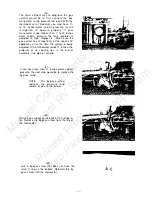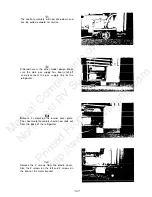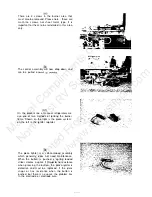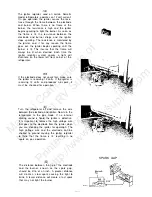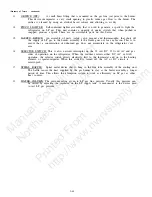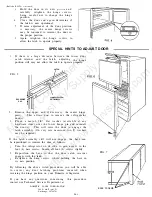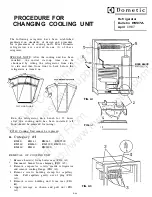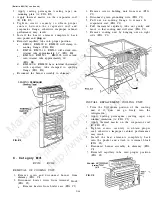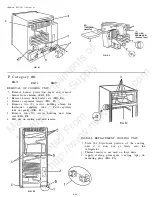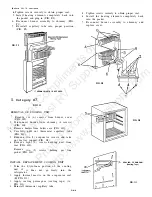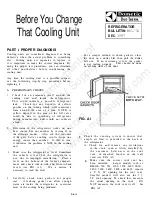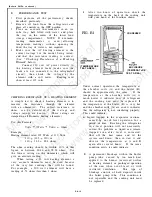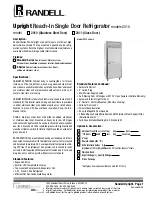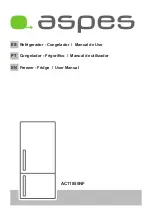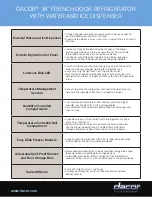
Glossary of Terms
MANUAL REFRIGERATION
1.
ABSORBER: Section of the cooling unit where the hydrogen and ammonia vapor are intermixed
in the absorber. Ammonia vapor returns to solution and the hydrogen returns to the
evaporator.
2. BOILER: Section of the cooling unit where heat is applied. This is where the ammonia is
partially separated from the water.
3. BY-PASS SCREW: Small brass screw located on any Dometic gas thermostat that regulates gas
flow in the low flame mode. There are three common sizes of this screw: S-17-350 BTU, S-
14-325 BTU, S-l l-300 BTU.
4. F o u n d o n c u r r e n t Dometic
m
a
n
u
a
l
GAS/ELECTRIC THERMOSTAT:
refrigerators, this device is held in place with "0"" ring seals in the gas line and replaces
separate electric and LP gas thermostat controls. On the LP gas mode, full line pressure is
directed through the thermostat to the burner until the thermostat senses that the
refrigerator cabinet has reached proper cooling temperature. At that rime an internal valve
closes and redirects the gas flow through the by-pass screw. This reduces the amount of LP
gas going to the burner assembly. The gas flow remains in this “by-pass” mode until the
thermostat senses that the refrigerator cabinet needs more cooling. Again, the thermostat
directs the LP gas flow through the thermostat at full line pressure until the cabinet
temperature is sufficient. On the electric mode the internal mechanism breaks contact
(continuity) when adequate cabinet temperature has been reached.
5. CONDENSER: Section of the cooling unit that cools the ammonia vapor into ammonia liquid.
6. COOLING UNIT: Self-contained, hermetically sealed set of steel coils where the refrigeration
process takes place. The chemicals involved in the cooling process include hydrogen,
ammonia, water and a rust inhibiting agent.
7. CUT-OFF VALVE (Shut-Off Valve): Valve where the incoming propane supply is attached.
This valve is direct-coupled to the selector switch by means of a steel clip. When the selector
switch is turned to the electric mode, the cut-off valve is automatically closed. When this
same switch is turned to the LP gas mode, the electric circuit is also automatically
interrupted.
8. EVAPORATION: A process that causes a liquid to turn into a vapor. Whenever evaporation
takes place, heat is removed.
9. EVAPORATOR: Section of the cooling unit where the cooling effect is produced. Liquid
ammonia evaporating in a hydrogen atmosphere takes place in the evaporator.
10. HEATING ELEMENTS: Elements that operate off either AC or DC voltage that create heat to
the cooling unit.
11. IGNITER-REIGNITER: The igniter-reigniter, used on certain Dometic model refrigerators,
operates on 12 volt current. On gas operation the igniter senses the resistance through the
flame between the electrode and burner. When there is no flame at the burner, the resistance
is high and the igniter begins sparking to light the burner.
As
soon as the flame is lit, the
resistance between the electrode and burner drops and the igniter stops sparking. The
resistance is monitored by the igniter, and if for any reason the flame goes out, the igniter
begins sparking until the burner is lit. This insures that the flame will always be lit when
desired. Each time the igniter-reigniter system sparks, a light will illuminate on the lower
left front corner of the refrigerator.
12. L.P. GAS PRESSURE: For the refrigerator to operate properly on LP gas, the gas pressure
should be set at 11” water column pressure. NOTE: use the test port at the rear of the
refrigerator to take this reading.
D-8-1
Manual
Compliments
of
Northwest
RV
Supply
Printed
From
http://www.nwrvsupply.com

